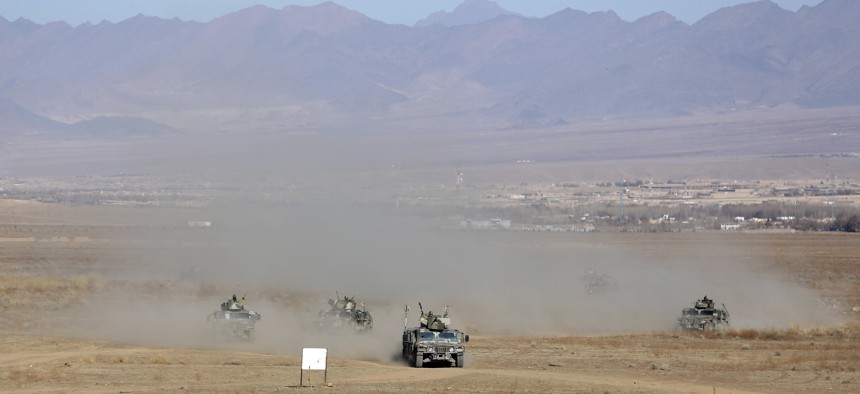
Afghan police special forces demonstrate their skills during an exercise in the Mohammad Agha district of Logar province, eastern of Kabul, Afghanistan, Thursday, Nov. 30, 2017. Rahmat Gul/AP
An Afghan Army Aviator Describes Iran’s Threats — and How to Meet Them
Beyond its support for the Taliban, Tehran is exploiting refugee flows and cultural ties between the countries.
Iran’s immediate military threat to Afghanistan is its support for the Taliban. But Tehran is also pulling three levers to prevent Afghans from unifying against its influence: recruiting Afghan refugees into Iranian forces; the interconnected economies along the countries’ border, and an effort to reshape Afghan education and culture. As they strengthen their security forces, Kabul and its people must stiffen their own cultural institutions, or lose a generation and possibly their country to Tehran’s sway.
In mid-November, a top Afghan official shocked his country, and international observers, by thanking Iranian-backed Afghan fighters for battling ISIS in Syria. In doing so, Mohammad Mohaqiq, deputy to Afghan chief executive Abdullah Abdullah, appeared to confirm what Iran had consistently denied doing: recruiting Shiite men from around the region to fight in Syria. Many of the recruits were among the 3 million Afghans who have fled to Iran to find work or respite from the war. What they got instead was a hard sell from recruiters from the Revolutionary Guards’ Fatemiyoun Division: “You came from Afghanistan to work and to make money. We will give you two options: Go to Syria, and we will pay you money, or go back to your country.”
Now Iran has redeployed some of these Afghan fighters to their home country, where they are fighting ISIS forces. When Mirza-Olang, a valley in the Sar-E-Pul province, was seized by anti-government forces in October, Iranian media initially tried to place blame solely on ISIS. But after the Afghan media reported that the attack was supported by Taliban — and that Iran had sent some Fatemiyoun Division fighters to help — Iranian media quickly acknowledged that it had been a joint Taliban-ISIS operation. This use of Shiite Afghans in the Fatemiyoun Division against the Sunni Afghans of ISIS could spark a religious war, the bloodiest that Afghanistan has ever seen.
A second key lever is the area around the countries’ 987-kilometer shared border, the area of Afghanistan most heavily influenced by Iran. In this area, especially in the Herat and Zabul provinces, people speak Persian with a heavy Iranian accent, they use Iranian money instead of Afghani in everyday trading, and they benefit from drug smuggling into Iran by bribing Iranian border police.
Moreover, Tehran has been blocking Afghan proposals to develop much-needed hydroelectric generating plants on two rivers that flow into Iran: the Hirmand, which brings 26 cubic meters of water per second; and the Harirod, with more than half a cubic meter per second. (Indeed, the struggle to control water resources may become a flashpoint between the countries. Kabul recently signed an agreement with India to re-build Salma Dam in Herat province with the aim of generating 42 megawatts. During the ceremony, Afghanistan’s President Mohammad Ashraf Ghani said that eventually Afghanistan will cease to allow water to flow to neighboring counties, including Iran. Iran’s President Rohani promptly responded that this move would “affect air pollution in Iran and will cause a regional crisis,” while one Iranian government-funded website concluded, “It will shut down life in half of eastern Iran, will cause massive migration, and most dangerously will eventfully lead Iran into a civil war.”)
But the most dire long-term threat to Afghanistan is Iran’s effort to riddle Afghan society with Iranian culture, propaganda, and organizations that will shape the attitudes and beliefs of the next generation of Afghans. In recent years, Iran has established schools, bookstores, and universities.
For example, there are 590 students studying at Azad University, an Iranian private university in Afghanistan. As well, Iran offers hundreds of bachelors, masters, and PhD scholarships to Afghan students every year. Most significantly, Iran provides great quantities of literature to Afghan private and public schools and universities — most of it written in Persian. By providing free cultural exchange visas, Iran allows Afghan poets and writers to visit Iran and exchange cultural thoughts.
Already, many intellectuals and some educated people quote Iranian authors for ostentation and pomposity. As philosopher Paulo Freire said, “For cultural invasion to succeed, it is essential that those invaded become convinced of their intrinsic inferiority.” Today or tomorrow, Afghans will be convinced that they cannot continue their educational system without Iran’s literature.
To fight back, the Afghan government must do several things. It must woo back the millions of refugees in Iran by providing shelter, jobs, and basic needs. It must fight Tehran’s influence in the border region by banning the use of Iranian currency and boosting border patrols to stop drug trafficking. The Afghan government must take a strong stand against Iran’s cultural influence by establishing an institution to provide literature, printing press, and free media that should oppose Iranian cultural influence. And finally, it must push back against citizens who openly support Iran’s policies in Afghanistan, using the provision of the Afghan constitution that allows them to be named as national traitors.



